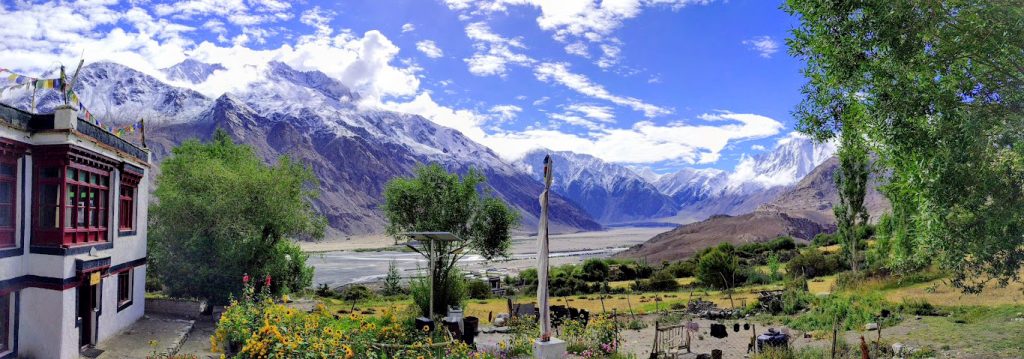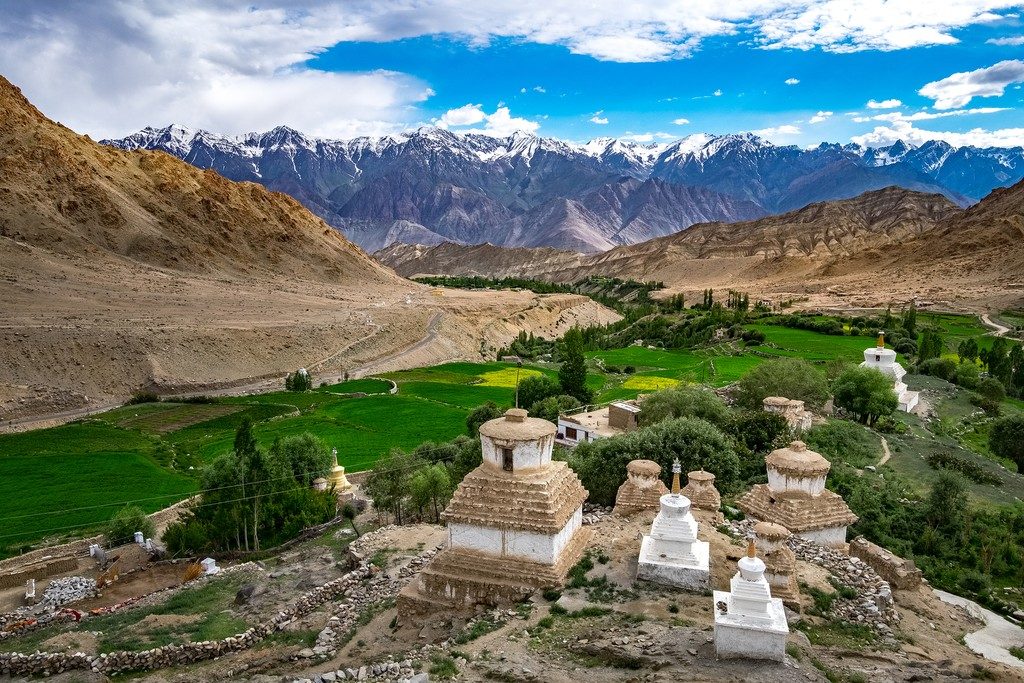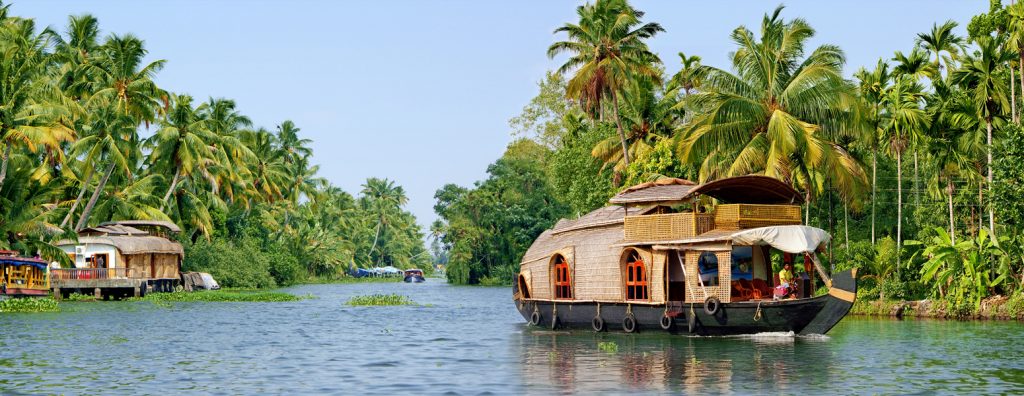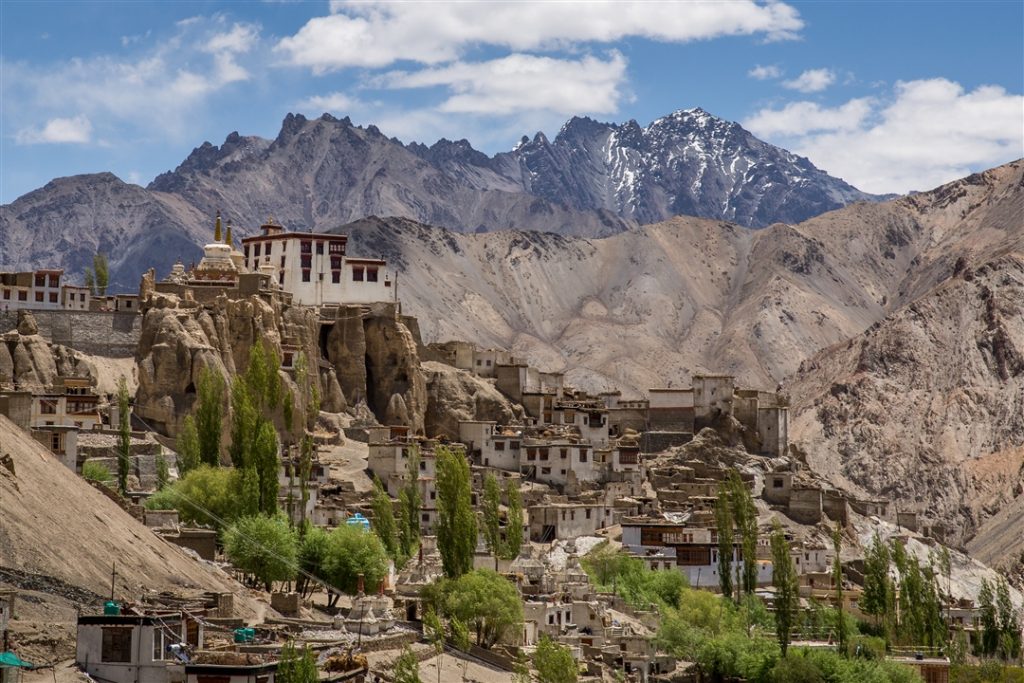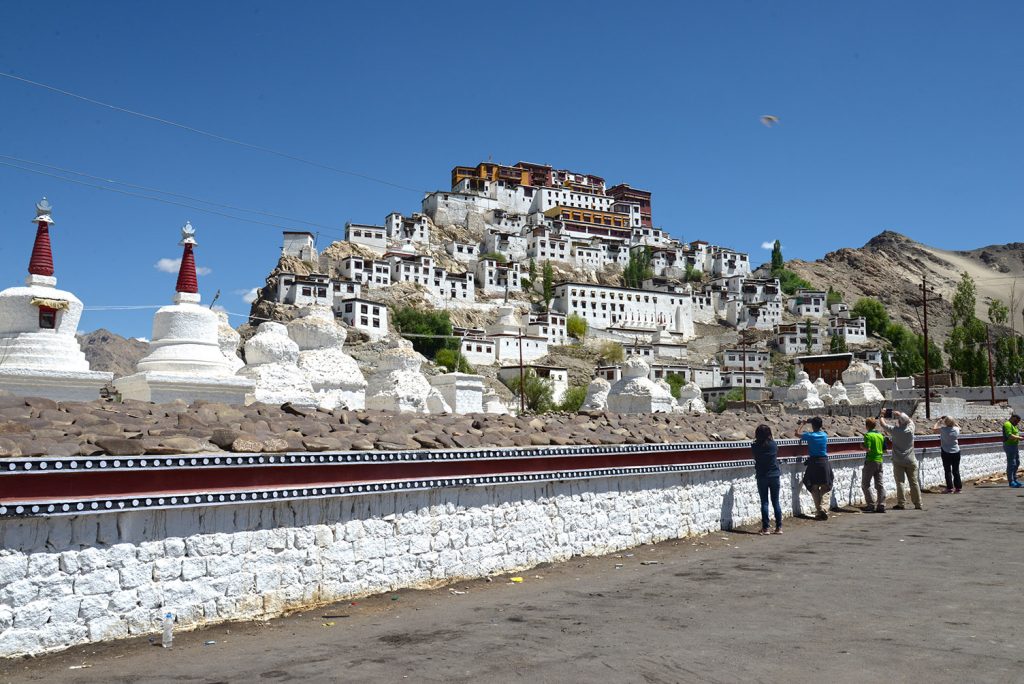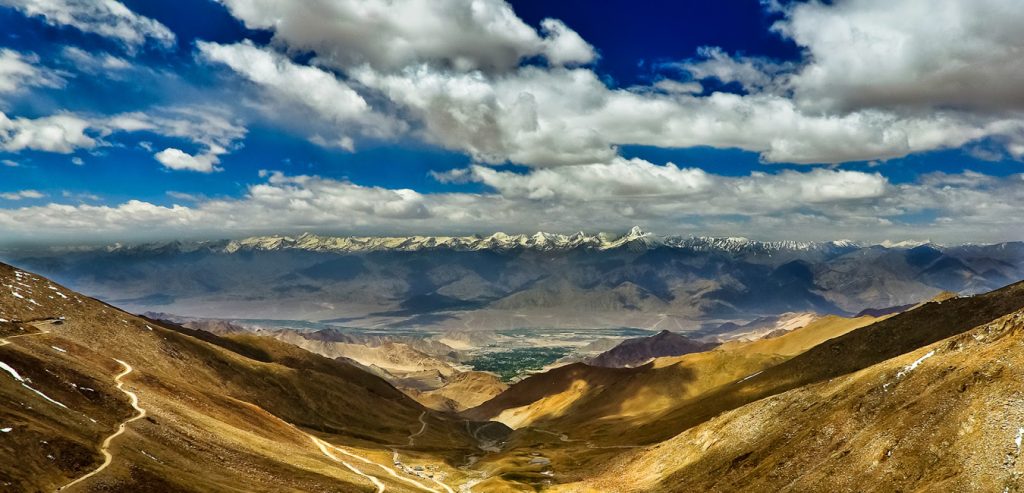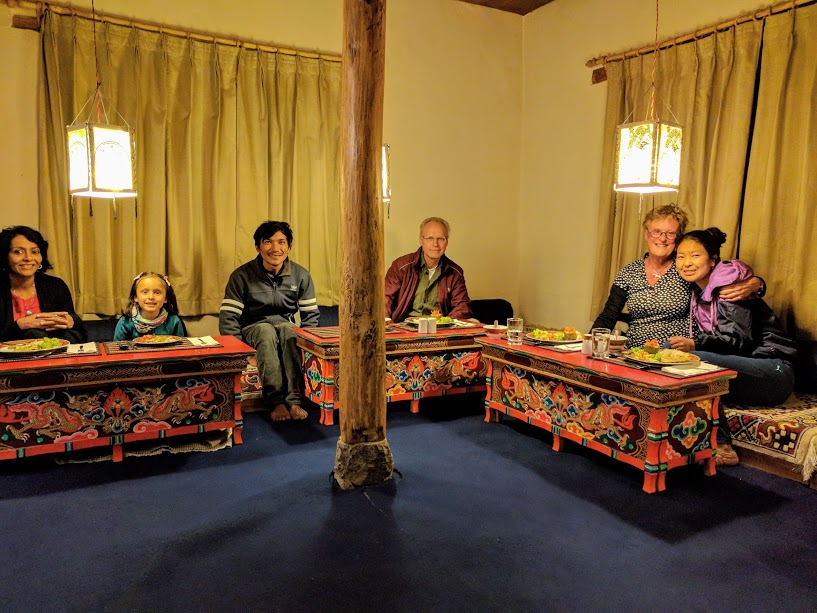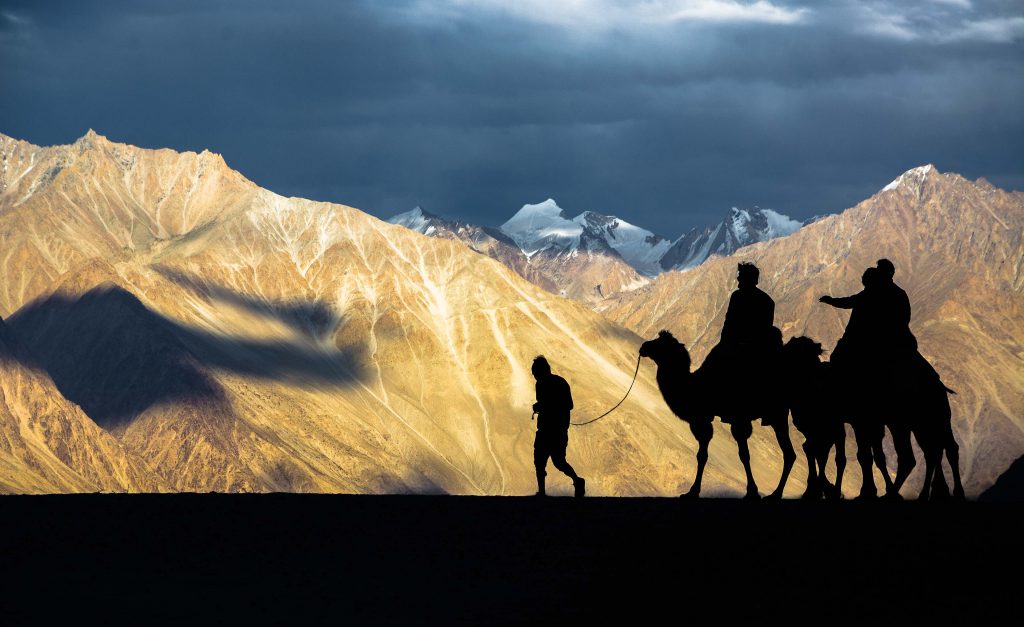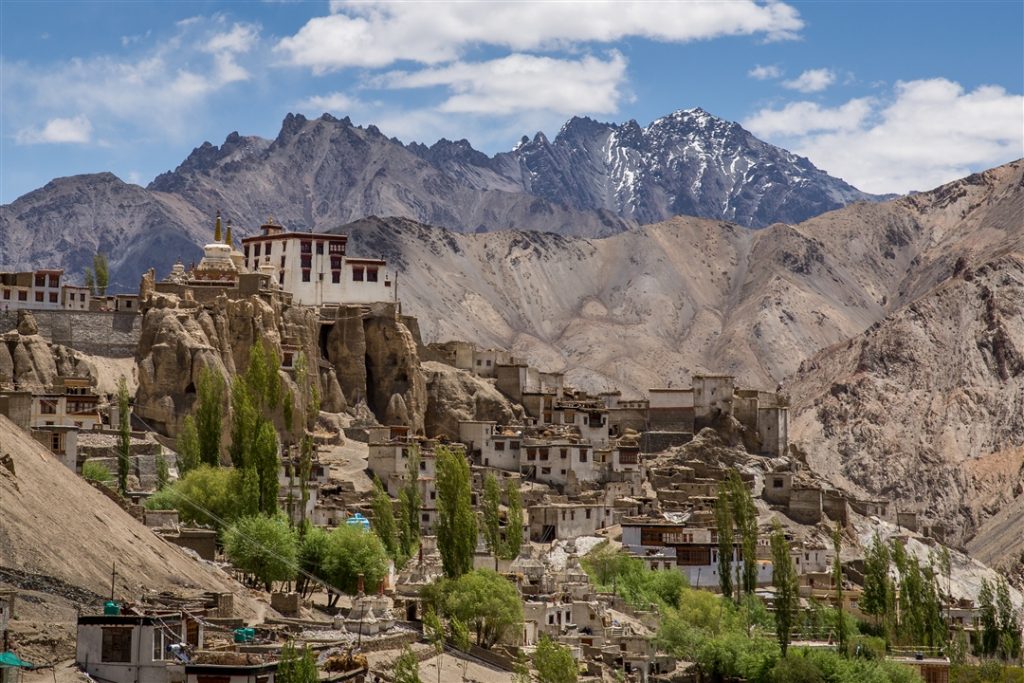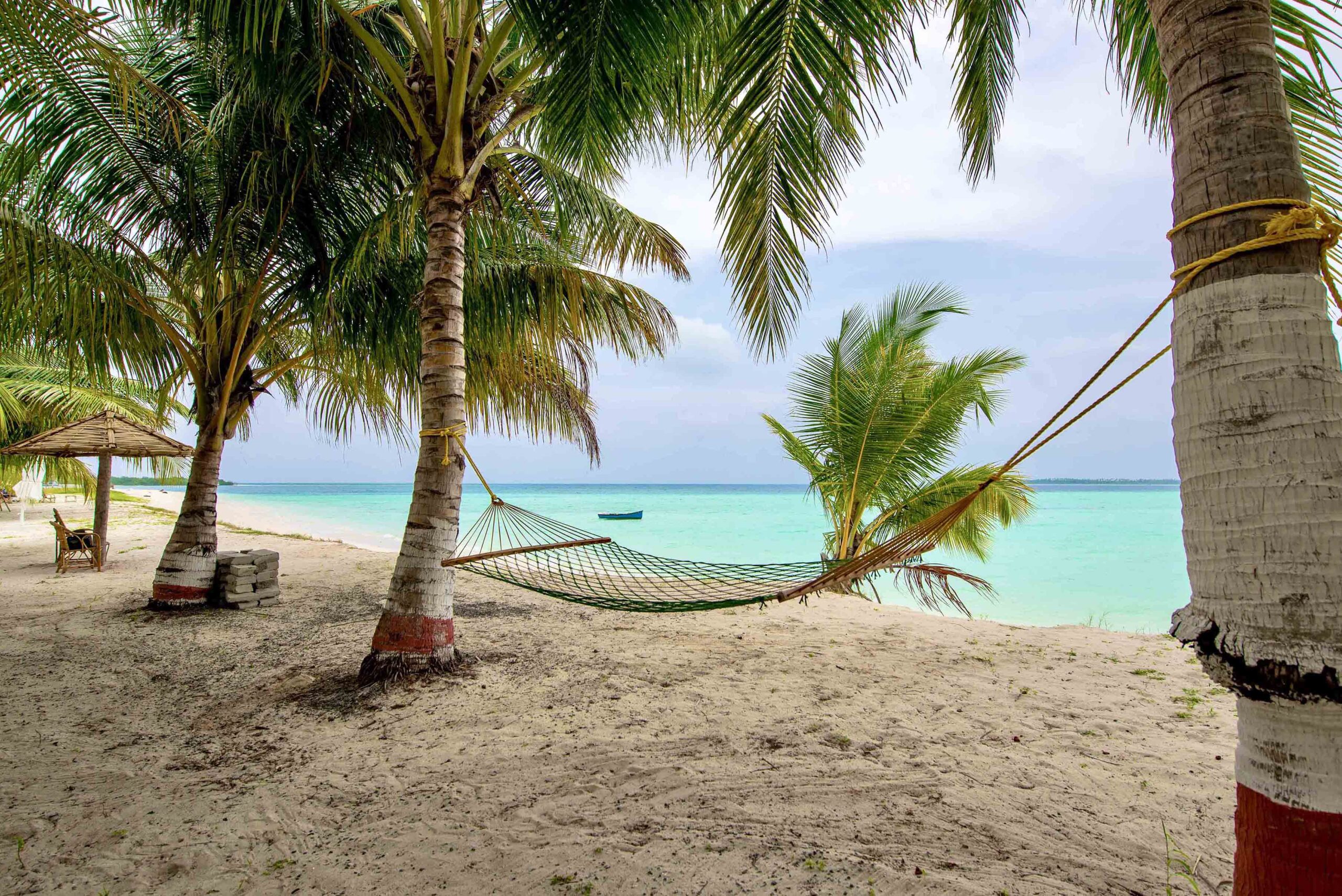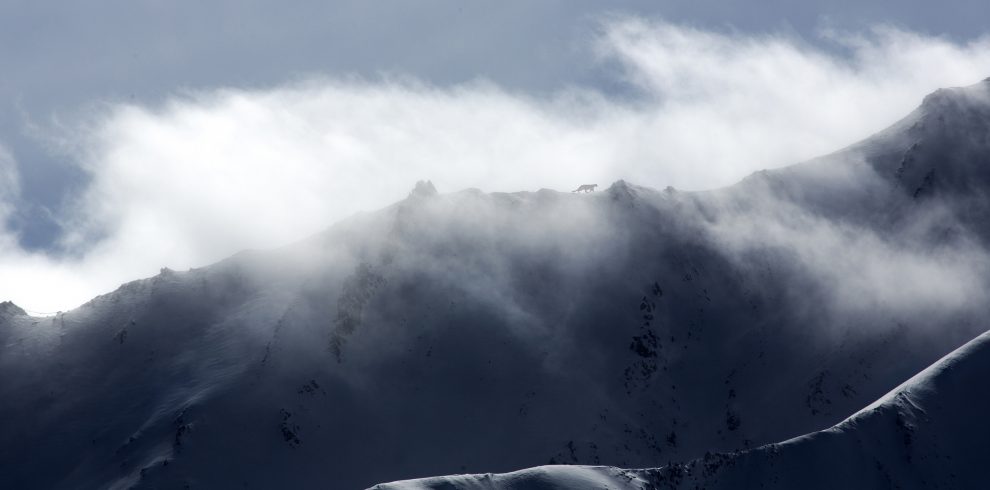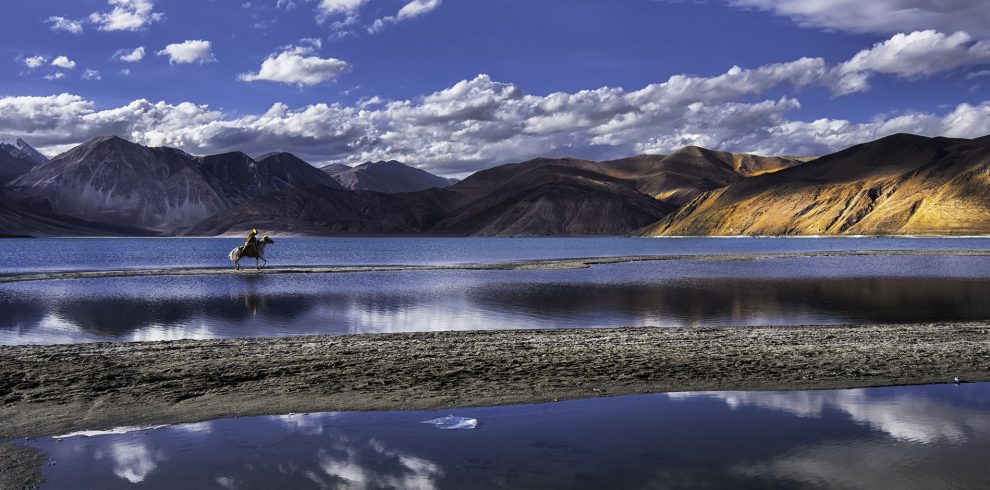Two third of the Mighty Himalaya lies in India, among which Ladakh offers some of the best vibrant mountain landscapes with decent infrastructure making it the top choice for family adventures in the mountains. We begin with a fascinating mountain flight to Leh, followed by a couple of days of acclimatization trips covering some intruiging ancient bhuddist monasteries. After Leh, we drive to Nubra valley which is famous for its outlandish landscape and also for the double humped back Bactrian camels, which will also include a ride on this fascinating camels enjoying the beautiful sand dunes of this cold dessert. From Nubra valley we will drive to the famous Panging Lake via Shyok village.
Overview
We will start a short and easy trek in the Sham Valley staying at beautiful homestays with local families sharing the culture and lifestyle. After this amazing trek we will fly to Delhi and visit Kerala- “God’s own country”. Here we will enjoy the lush green hills colured by the monsoon, visit tea and spice plantation, Periyar national park with its Tiger trails and a fabulous house boat ride along the scenic back waters of Kerala marked with swaying coconut palm trees. We will stay in Tree houses and houseboats.
What makes this trip special
- Explore the vibrant Leh Bazaar on a walking tour.
- Visit to the old Summer Retreat and to some of the biggest monasteries of Ladakh
- Double hump Bactrian Camel safari at Nubra valley
- Stay at “glamping” safari tents at Nubra valley
- Walk past the beautiful villages of Hemis Shukpachan and Tingmosgam
- Visit the famous monasteries of Alchi, Lamayuru and Likir
- Experience the car roll uphill on its own at Magnetic Hill
- Homestay at some of the beautiful remote villages of Ladakh
- Visit the lush green hills of Munnar in Kerala
- Visit tea plantation and spice plantations
- Elephant rides and boat rides in Periyar Tiger reserve
- Stay at tree houses
- House boat ride along the back waters of Kerala with overnight stays in the house boat.
Itinerary
Altitude: 216m
On arrival to Indira Gandhi International Airport at New Delhi and finish with the immigration and custom formalities, our representative will meet you at the Main Exit with a Hi On Life Adventures placard. It is about 15 to 20 mins drive to the Aerocity where we have chosen your hotel for the practicality for the next days early morning domestic airport transfer. When you arrive at your hotel you will be briefed about your trek and “do’s and don’ts” while your stay in India. In the evening we will have a welcome dinner to begin the taste of India at one of the finest dining in New Delhi.
Altitude: 3500m
Flight duration: 1 hour 25 mins
Early morning drive to the domestic airport to fly to Leh. Be prepared for an extensive security checks for your own safety owing to the fact that Leh is strategically located close to Pakistan and China. Baggage allowance Delhi-Leh is only 15kg per person, unless you have a through ticket on the same airline internationally. However, excess baggage charges are only $5 per kilo. It will be an early morning flight to Leh which is a fantastic mountain flight. The flight takes about 1 hour and 20 mins to Leh and approach to the airport at Leh is extremely scenic, so get your cameras ready. The airport at Leh is also an Indian Air Force Base, therefore it is heavily guarded and again extensive security checks. We will be received at the airport by a representative from Ladakh and will be transferred to our hotel. An important component of our trip that we must adhere to is the acclimatization required due to high altitude. Do not plan on heading out at all today. Rehydration is the key to cope up with the high altitude, so drink water regularly. We will take this first day at high altitude with leisure, maximum exertion should maybe be a small stroll outside to the neighboring shops.
Overnight Hotel in Leh
Altitude: 3500m
Explore duration: 4 to 5 hours
Leh is the ancient capital of Ladakh. There are many hilltop forts and palaces in Leh, including the Royal Palace which overlooks the town. Today we visit some of these forst and palaces which is excellent also for getting acclimatized to this high altitude. In the morning we will begin with a walk to the small fort and monastery complex of Namgyal Tsemo (mid-16th century) which overlooks Leh. The complex is believed to be the earliest royal residence in Leh. Then after we will visit Leh Palace built in the 1630s by Sengge Namgyal. After lunch we will visit the gleaming white Shanti Stupa (“Peace Pagoda”) which is situated on a hilltop to the west of the city.Leh is situated on the old Silk Route and still has a trading tradition. It is well worth wandering around the colourful bazaar in the afternoon.
Overnight Hotel in Leh
Altitude: 3050m – highest elevation 5400m- crossed by jeep ride (Khardung la)
Drive duration: 5 hours (160 kms)
The Nubra Valley is situated at the end of the road, at the cap of India, in the Ladakh region of Jammu and Kashmir. It is a hidden treasure with fine silver sand dunes cradled by gargantuan mountains. We will have obtained our Inner Line Permit to enter Nubra Valley and these will be inspected as we leave Leh. We begin to climb from Leh on a winding road upto Khardung La (5,400m) which is the highest motorable road in the world. After spending some moment at this pass we start to decend to Diskit. Diskit Monastery is the oldest and largest Buddhist monastery in the Nubra Valley. It belongs to the Gelugpa (Yellow Hat) sect of Tibetan Buddhism. It was founded by Changzem Tserab Zangpo, a disciple of Tsong Khapa, founder of Gelugpa, in the 14th century. After passing Diksit we then continue into the Shyok Valley to Hundar, one of the few areas in the world where grazing bactrian camels are seen.The Shyok River meets the Nubra or Siachan River to form a large valley that separates the Ladakh and the Karakoram Ranges. The average altitude of the valley is about 3,050m above sea level.
Overnight at Eco Safari Camp or Dessert Deluxe camp
Altitude: 3050m
Safari duration: 2 hours
Drive: 2 hours (80 kms)
Popularly known as the Valley of Flowers, the Nubra valley is a district comprising the valley of the Nubra river, and that of the Shayok both above and below their confluence. This lovely and fertile valley with meandering rivers was originally part of the trade route between Tibet and Turkstan. It was the envy of the rulers of Turkistan who tried to capture it several times. The main village in Nubra Valley is Deskit, which has a regular bazaar consisting of a single line of shops, and a beautiful Gompa found in the 15th Century. Native to the steppes of central Asia, the Bactrian camel has two humps, in contrast to the single-humped camels found in Rajasthan and other parts of India. The Bactrian camels were the main mode of transport when Ladakh was an important stopover on the ancient trade routes with Central Asia.Joyrides on the Bactrian camel through the sand dunes is a must do while you are at Hunder. Camel safari takes around two hours.After the camel ride we will drive to Turtuk village. The drive to Turtuk passes through the Shayok valley, which is 80km of scenic magnificence marred only very occasionally by military installations. The end of this valley briefly narrows near Changmar, the western limit of Ladakhi-Buddhist culture. Thereafter, the green splashes of village are culturally and linguistically Muslim Balti.
Overnight at Turtuk Holiday Resort
Altitude: 3200m
Exploring duration: 3 hours
Drive to Leh: 7 hours- 180kms
Turtuk was discovered by two Turkish men namely "Chuli and Yangdrung" who wandered and came to this place and settled here. Today their generations here are known as Chulipa and Yangdrungpa. Turtuk was once used to be mainstream silk trade route across Baltistan. Also known as "Apricot County of India" the area have abundant fruits and vegetable cultivation.Turtuk is a raised patchwork of fields and houses on terrace ledges above the main road. In the summer locals can be seen carting huge bundles of barley straw on their backs between the apricot trees. Upper Turtuk has breath taking views towards serrated high peaks in Pakistan: the frontline is only 7km away. Turtuk itself was part of Pakistan until the 1971 war.After exploring the villages of Turtuk and Bogdang, we will drive back to Leh.
Overnight Hotel in Leh
Drive duration: 58 kms (1 ½ hours)
Trek distance: 10.1 kmTrek duration: 3-4 hrs
Elevation gain / loss: +431m / -274m
After breakfast at Leh, we begin with a 58 kms drive to Likir village (3650m), which is the starting point of our trek. From Likir the route heads west up to Phobe La (3580m) and reach Sumdo village. From here, the trail goes steadily upwards till we get to Chagatse La (3630m). Across the pass is the village of Yangthang (3630m). Although the distance is short, the route can be warm, without any shade or water.
Overnight at Homsetay
Trek distance: 10.4 km
Time: 3-4 hrs
Elevation gain / loss: +238m / -283m
The trail heads north, descending for a bit, crossing a stream before climbing up again to Tsermangchen La (3750m) which offers breath taking views of the surround landscape. After a short rest at the pass we head down to Hemis Shukpachen, which is considered as one of Ladakh’s prettiest villages. There are large barley fields and several running streams surrounded by shady willow trees providing a touch of green to the otherwise desolate, Rocky Mountains. It is an easy walk with gentle gradients crossing the passes.
Overnight at Homsetay .
Trek distance: 11.3 kmTime: 4 hrs
Elevation gain / loss: +312m / -714m
It is another fairly easy trek today. The trail begins with a gentle climb between two hillocks west of the village until it veers south and climbs steeply up to the Mebtak La (3750m) marked by prayer flags. From the pass we descend along a gorge, passing through a charming village with apricot orchards and continue to our last night camp at Temisgam village.
Overnight at Homsetay
Drive from Temisgam to Leh: 90 Kms
On the last day of the trek, we will again go for an easy trek downhill all the way on the main road where our car will be waiting for us. We will drive towards Leh en-route we will visit the Lamayuru Monastery and Alchi Monasteries.
Overnight Hotel in Leh
Flight duration: 1 hour 25 min
Sightseeing duration: 3 hours
Early morning drive to the airport to catch early morning flight to Delhi. Once again prepare for an extensive security checks. Lithium Batteries (eg spare camera batteries) – must be in your checked luggage for the return flight from Leh back to Delhi. On arrival to New Delhi we are transferred to our hotel. In the afternoon we take a Rikshaw ride through the narrow lanes of Old Delhi- a “must do” fascinating trip.
Overnight Hotel in Delhi
Drive: 5 hours
Sightseeing duration: 1 ½ hour
We begin early morning on a 233 km drive to Agra. The drive is comfortable and the road condition is of “Western standards” on the Express Highway. Before we go to our Hotel at Agra, we visit the Agra fort. Agra Fort is a massive and awe-inspiring fort built by the Emperor Shah Jahan during the Mughal reign in India. From here you can get the first glimpse of Taj Mahal across the river Yamuna. After visiting Agra fort, we check in to our hotel.
Overnight Hotel in Agra
Drive: 5 hours
Sightseeing duration: 2 hours
An early morning visit to Taj Mahal to get the beautiful views of the first lights on this fabulous monument and also to avoid the crowd, which get very heavy during the day. Taj Mahal is one of the 8 wonders of the world and is one of the most beautiful monuments in the world. Neither any words, nor any pictures can justify the beauty of this amazing monument. We will spend a couple of hours at the Taj Mahal and then drive to our hotel. After breakfast, we drive back to New Delhi to our hotel. We arrive New Delhi early afternoon, so if you would wish to go to the main center for some shopping/ sightseeing, your guide can arrange or escort you.
Overnight Hotel in Delhi
Flight time: 3 to 4 hours depending on connection flight
Cochin to Munnar (135km/4.5hrs)
On reaching Cochin, we will be greeted by our representative in Kerala. We will drive from Cochin and reach Munnar by afternoon. On the way we visit Kodanadu elephant care centre, Cheyyara waterfalls, Valara waterfalls, Attukadu waterfalls, Spice plantations etc. We will not rush to cover the sightseeing points but will allow you to take your time and will follow your pace to get the full enjoyment of each point you cover.
In the afternoon you will arrive your hotel which is a beautiful tree house.
Overnight at Tree house in Munnar
Full day sightseeing
Sightseeing destinations includes Eravikulam national park (Raja Malai), Mattupetty dam, tea estates, eco point, spice plantation, rose garden, tea museum etc. Again, we will not rush you to cover the sightseeing tour but we will let you grasp in the experience at your own pace.
You can also enjoy boating in the lake, rock climbing, trekking (optional)
Overnight at Tree house in Munnar
Drive: 3 hours (91 kms)
After breakfast we drive to Thekkady. Upon arrival we check in to our hotel which will be a tree house. Later we will visit Periyar Wildlife Sanctuary where we will embark on an animal safari.
Thekkady is famous for wildlife as well as for nature lovers. Its cool climate, scenic vistas, lush greenery and the exotic wildlife sanctuary makes it an amazing destination. Thekkady brings the live images of elephants pack walking along the pristine lakes and rivers in Periyar wild life sanctuary and boating in the lake. Its spice gardens surrounded by aromatic air, chains of lush green hills, lovely waterfalls and the call of the nature gives a soothing experience.
Overnight Treehouse in Thekkady
Drive to Kumarakom: 3 h 30 min (133 km)
House boat: 21 hours
We drive to Kumarakom after breakfast. On arriving Kumarakom we embark the houseboat.
Kumarakom is a is a sleepy little village on Vembanad Lake in the backwaters of Kerala. It’s laced with canals, where houseboats ply the waters. It offers wide variety of flora, exotic sightseeing, boating and fishing experience. Kumarakom Bird Sanctuary is home to many species including cuckoos and Siberian storks.
Enjoy the scenic houseboat ride through the lovely backwaters and canals lined with coconut palm trees.
Overnight stay at Houseboat.
After a peaceful night in the houseboat we will enjoy a serene morning enjoying the beautiful vista form the houseboat. Enjoy a delicious breakfast and disembark the houseboat and check in to hotel. You can spend at leisure- swimming at the hotel pool, enjoying the lake or shopping.
Overnight at Hotel at Kumarakom.
Kumarakom to Cochin: 1 h 21 min (53.3 km)
There is amazing spots to practice Yoga in the morning. You can spend your morning at leisure. According to your international flight time, we will drive from Kumarakom to Cochin. We suggest you to have your flight back home from Cochin. There are very good connection flights from Cochin to any country in Europe. Having your return back flight from Cochin gives you the oppertunity to explore the vivrant city of Cochin.
Cochin sightseeing includes Fort Cochin, Navy museum, St. Francis church, Chinese fishing net, Santa cruz Basilica, Jewish synagogue etc. You can also find some time for shopping at Cochin. Or simply take a leisurely walk in the town.
If you have your international departure flight from New Delhi, will arrange your connecting flight from Cochin to New Delhi accordinly.
About India
India, officially Republic of India, is the seventh largest country in the world by area. It also has the second largest population in the world with over a billion people, and prides in being the largest democracy on Earth. It is an extremely diverse country, with vast differences in geography, climate, culture, language and ethnicity across its expanse.The earliest archaeological traces are from 7000 BC in Mehrgarh, which grew to be the “Indus Valley Civilization”, which is one of the earliest civilizations in the world. By 3300 BC, this civilization had well-planned towns and well-laid roads.India’s culture and heritage are a rich combination of the past and the present. It offers the visitor a view of fascinating religions and ethnography, a vast variety of languages with more than 438 living languages, and monuments that have been present for thousands of years.From the tallest mountain range in the world, Himalaya, to sun washed beaches, dense sub-tropical jungles to deserts, tranquil temples and rich architectural ancient monuments to frenetic bazaars, lantern lit villages to software supreme cities, India has it all. There’s simply no other word that captures the enigma that is in India. With an ability to aspire, frustrate, thrill and confound all at once, India presents an extraordinary spectrum of encounters for the traveler. India also boasts on having one of the wildest and largest culinary varieties in the world, each region presenting their own specialty. This is one country that will definitely jostle your entire being. It’s a place that fires the imagination and stirs the soul like nowhere else on earth.
India at a glance:
- Area: 3,287,590 Sq Kms
- Population: 1.2 billion
- Capital city: New Delhi
Ladakh
Ladakh, “The land of high passes”, is a region in the Indian state of Jammu and Kashmir. Although, rock carvings found in many parts of Ladakh indicate that the area has been inhabited from Neolithic times, not much is known about Ladakh before the 1st century. During the 2nd century when much of eastern Ladakh and western Tibet was still practicing the Bon religion, Buddhism started to spread into western Ladakh from Kashmir. In 842 Nyima-Gon, a Tibetan royal prince annexed Ladakh after the break-up of the Tibetan empire, and founded a separate Ladakhi dynasty. During this period, Ladakh acquired a predominantly Tibetan population. Also known as “Little Tibet” Ladakh’s culture and history are closely related to that of Tibet.The largest town in Ladakh is Leh, followed by Kargil. Ladakhis are Tibetan-Mongoloid in appearance although traces of Kashmiri Moslem influence can also be seen. The predominant religion in Ladakh is the Tibetan form of Buddhism, although Islamic influences are found from the Kashmir Valley as far as Kargil, and there are some Christian families in Leh.
Some interesting facts about Ladakh
- Ladakh is the highest settlement in India.
- The fields at Korzok, on the Tso-moriri Lake, at 4,600m are widely considered to be the highest cultivated lands in the world.
- A Bailey bridge between the Suru River and Dras River in Ladakh, is the highest bridge in the world at an altitude of 5,602m.
- Only place in India where twin humped Bactrian camels can be found.
- Ladakh is home to the mystical Magnetic Hill, which is a so-called “gravity hill”. The alignment of the road with the slope of the background can give the illusion that cars are able to drift upwards.
- The Pangong lake in Ladakh is one of the highest salt lakes in the world
- Ladakh is also home to some of the rare species of wildlife including Snow Leopard, Kyang (wild ass), Black Necked Cranes, Himalayan Ibex and several other species of brids and animals.
Recommended preparation:
Recommended preparation:Although it is an easy trek, average fitness is essential, as we walk along gravel/ dirt paths. The trails are easy but have some uphill climbs as well as down hills. Walking or jogging 45 mins to 1 hour for at least two times a week on undulating terrain or on a tread mill for at least 3 months prior to departure. Cycling is recommended. Easy hikes on weekends with a daypack in variable weather conditions are also recommended.
A Day On Your Trek
Although each day is different, considering the weather, general pace of the group and length of the days walk, in general your day begins with a wake up tea at around 6 to 6:30 in the morning. You will then be provided with a bowl of warm water for washing. Then you will need to pack your duffel bag and your daypack and come to the dining tent for breakfast. After breakfast we will hit the trail and usually walk for about 2 to 3 hrs before we stop for lunch. Lunches are usually picnic packed lunch. We allow you about an hour rest during lunch, which will also give enough time for the staff to prepare lunch, wash dishes and have their lunch and pack. Usually after 2 to 2 ½ hrs of walking we finish the days walk by 4 PM. Tea/ Coffee and snacks will be served on arrival to the camp. Your Group Leader will often organize side trips in the afternoon.Your dinner will be served around 7 PM.
Food and water
While on the tours, we will stay at luxury “glampings” or hotels/ resorts, therefore all meals are provided by the hotels. On the trek we stay at local homestays. Although it is a great experience to share the local lifestyle and get to know them, food can be monotonous. Therefore we always send our experienced cooks on such trips. Our cook will help at local homestays to prepares hot food which is normally a very balanced diet comprising of fresh vegetables and breads, to pastas and sandwiches and occasionally even cakes and pizzas. Breakfasts are usually bread eggs and cereals, and lunch and dinner are a three course meals. We make sure that you get the required amount of carbohydrates and proteins and vitamins.
We provide boiled and treated water 4 times a day.
High Altitude
On this trip you will barely spend some minutes at 5600m on top of the Khardungla (5600m) while driving to Nubra Valley. The rest of the trip will be spent at moderate altitudes between 3300m to 4000m. Although it is not a serious altitude trek, it is still very important to understand the affects of altitude. The greatest provocation is going too high too fast. Hi On Life Adventures’s itinerary has been carefully designed to minimize the effects of altitude. We ascend slowly and surely allowing enough time for safe acclimatization. A close watch is kept on all trekkers by the group leader who is trained to recognize the symptoms of AMS which are severe headaches, nausea, lethargy, loss of appetite serious breathlessness even at rest. If any trekkers show such signs they will be descended to relatively lower and safer altitude. The Group Leader’s decision on evacuating such person to a safe altitude is final. Do not medicate yourself without first informing your group leader. Going to altitude slowly with adequate rest and adequate intake of fluid (3 to 4 litres per day), you will most likely have no problems apart from breathlessness on hills which is completely normal as the percentage of Oxygen in the air is relatively lower to that at sea level. The most important thing is not to worry about altitude because our team is there to take care of you.
Staff
Group leader: your most important member of your staff. Our Group leaders are highly trained in all aspects of the trek, conservation, first aid specializing onaltitude sickness, emergency procedures and have extensive knowledge of the natural history of the area.
Sherpas: Their job is to lead your way and distribute equal loads to the porters and also help clients and other staff when need arises.
Horsemen: They are responsible to transport your duffle bags and their job finishes once they reach the designated lodge. The loads are carried by their horses and they take care of the horses and our baggage.
Weather
The best time for this trek is June till August. It is summer time in Ladakh and the temperatures are pleasant at high altitude. Another typical thing about the climate in Ladakh is that the temperature varies enormously. It can be 28 C+ on a sunny day and within an hour the temperature could drop below 10 C if it gets cloudy. At altitudes above 4500m the night time temperatures could drop just below freezing.
Recommendations for things you should bring:
- Water bottle: 2 bottles min 1 liter each, (should be able to hold hot water)
- Day pack: small size 25-30 liters
- Sunglasses: Poloroid/ UV protection 2-4
- Duct tape: Small roll for emergency fixing of torn jacket/ sleeping bags etc.
- Stuff bags: Small stuff bags or plastic bags to organize you duffle bag
- Money belt
- Toiletries: Your essentials. We provide toilet papers
- Towel: Quick dry travel towel
- Torch: Preferably head lamp
- Penknife
- Disposable lighter
- Sewing kit
- Medical kit: As per your prescriptions. It should be noted that the group leader will be carrying a first aid kit.
Optional
- Walking sticks ( highly recommended)
- Cameras
- Knee guard for those with bad knees.
- Daytime snack (chocolates/ dry fruit trail mix)
Clothing
- Trousers: 2 lightweight for easy walking, stretchable running trousers or comfortable evening wears
- Shorts: 1 (Not too high cut revealing ones)
- T-shirts: 2 to 3 light cotton
- Full sleeves T- shirts: 2 preferably poly propylene or wool.
- Hats: 1 Sunhat and 1 woolen one for colder days
- Buff (cover for your mouth and keeps your neck warm)
- Gloves: 1 warm woollen/ fleece
- Thermal underwear (baselayers): 2 pair light weight tops and trousers, preferably woollen
- Socks: At least 4 pairs (both thin and thick woollen ones)
- Jackets: 1 fleece/ wool and 1 Gore-Tex wind/waterproof. Please note that we provide down jackets
- Walking boots: Preferably waterproof
- Gym shoes/sandals For evenings
Healthy and trouble free holiday
Please consult a doctor for vaccination against Typhoid, Meningitis, polio, and hepatitis. If you have special dietary requirements or allergies, please give us a list of what you can and can’t eat so that we can provide proper food for you. If you are undergoing a course of prescription medicine, please ensure that you have sufficient supplies for the entire holiday. Some types of drugs including antimalarias have side effects at high altitude; therefore please consult your doctors regarding these drugs. The places you trek are mosquito free and there has been no report on malaria in Ladakh. However, if you add the extensions to Central and South India, please consult your doctor regarding Anti Malaria pills.
Insure yourself
We highly recommend you to take a comprehensive Personal Travel Insurance before leaving home. This should cover for your loss of baggage, airline delays, sickness, and accidents. It should cover all incuring costs for evacuations.
Money Matters
The ideal currency to bring with you is USD or Euro. You can exchange them in Delhi or Leh. You can also draw money from ATM machines in New Delhi or Leh. The exchange rate is 1 USD = 62 Indian Rupees approx. (subject to change)
In Delhi and Agra: During the entire trip the all meals are included except for a couple of lunches and dinners while at Delh. Delhi has a wide variety of restaurants with a very wide range of price. Depending on where you eat, each meal will cost anything between 5 to 25 USD + drinks. Plus 20 to 30 USD for your taxis if you wish to go around the city.
On trek: Basically there are no place where you can spend money on the trek. However, in few places you might find small tea shops that sells cold drinks, chocolates etc. It is recomended to bring around 5 USD per day. This money is chocolates, soft drinks and beers etc and also for small donations in the monasteries.
On Central India and South India extensions: All hotels are on full board, therefore other than your expenses of your personal nature, all costs are covered.
Tipping
Although tipping is entirely optional and personal matter the following is recommended as a guideline
In Delhi, Leh and all other cities: for bellboys, waiters and porters 50 to 100 Indian Rupees
On the trek: At the end of the trek it is a customary to tip the field staff. The recommended amount is 50-100 USD depending on group size. The Group leader will collect the tip and then split it between the staff and put it in envelops so that the trekkers can give it to the staff during the “Farwell Ceremonies”.
Please note- the Group Leader is not included in this tip. If you want to tip the Group Leader, you can do it separately.
Some Do’s and Don’ts
Ladakhki people treat visitors as special guests. Although they will never rebuke you publicly for unknowingly offending them, we must consider their culture.
While in Ladakh please observe the following:
- Full or partial nudity is not accepted.
- Over display of affection between men and women, especially in temples and monasteries are discouraged.
- Please remove your shoes before entering monasteries and temples.
- Never point the soles of your feet at a person or shrine.
- Locals walk around the Mani walls and Stupas in a clockwise direction as a respect and they expect you to do the same although it is not compulsory.
- Please ask before taking pics of a person or his/her child
Some useful tips while travelling in Delhi and Agra
Dress code: Dress sensibly and don’t walk around alone at night. For men knee length shorts and t shirts and sandals are best to cope up with the heat but in some temple and mosques you need to wear long trousers. For women it would be wise to cover up and dress modestly to avoid unwarranted advances. Light cotton trousers or knee length skirts are ideal and avoid bare back dresses.
Personal space: The concept of personal space is almost nonexistent in almost all over India. Whether you’re standing in a queue or walking in a crowded Bazaar, get used to moving shoulder-to-shoulder.People in North India tend to stare a lot: Please don’t be offended because most of them do this out of curiosity. Easy way to deal with this is to not make direct eye contact with strangers and passersby. Get used to it and don’t let this make you uncomfortable.
Bargaining skills: In shopping malls the prices are fixed and you cannot bargain. However, in rest of your shopping adventure, it is inevitable that you will be exploited to a certain degree, the simple fact is that most vendors know you have money. Skillful bartering takes practice- a beginner’s rule of thumb is to cut thestarting price in half and then work your way to a middle ground.
Beware of Pickpockets: The streets of Delhi can become very crowded, exposing you up to a risk of being easily pick-pocketed. Keep your money in your money belt or in a forward facing backpack to avoid any thieves. If you need to take money out of your wallet, it is best to find a quiet spot and do it quickly to avoid being robbed.
Beggars: You will likely see things that strike your emotional core, but it is important to realize that these are deep rooted problems with no easy fix. Moreover if you give money to one beggar, within secs you will find yourself surrounded by a dozen other beggars from children to adults. Also keep in mind that beggar mafias control much of the inner city.
Street Hawkers: When you walk out of the sightseeing points you will meet several hawkers trying to sell you small souvenirs from pics and all sorts of things. Do not engage in a bargain or converstation unless you really want to buy them. They can be very pushy sometimes.
Go With the Flow: Despite the fact that the cities in India can be tiring with all the staring, crowded streets, beggars, pestering hawkers’ etc. try not to care about the small stuff. If you get caught up and stress about the little things, you will miss out on the bigger picture, which is that you are in one of the most distinctive and important cities in the world. The city will often come to feel like another planet entirely.
“Teaching children about the natural world should be seen as one of the most important events in their lives” Thomas Berry/ The Dream of the Earth

